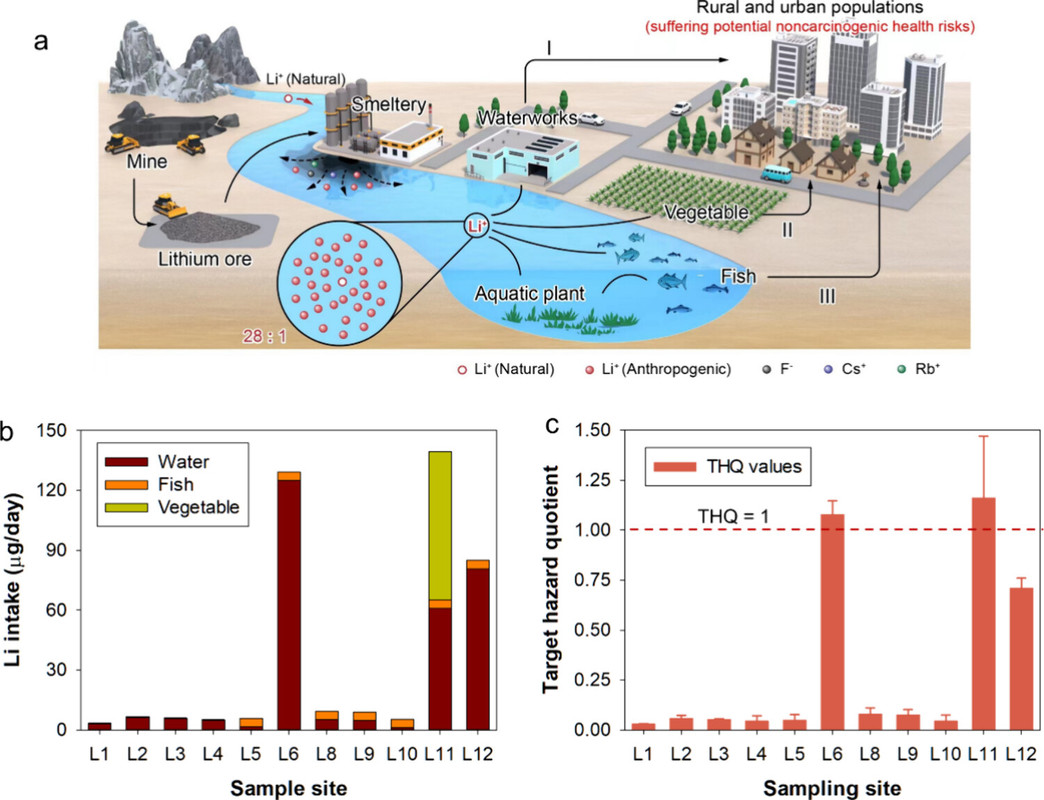Science
Related: About this forumLithium Pollution and Its Associated Health Risks in the Largest Lithium Extraction Industrial Area in China
The paper I'll discuss briefly in this post is this one: Lithium Pollution and Its Associated Health Risks in the Largest Lithium Extraction Industrial Area in China Xuezhi Yang, Haonan Wen, Yin Liu, Ying Huang, Qun Zhang, Weichao Wang, Haiyan Zhang, Jianjie Fu, Gang Li, Qian Liu, and Guibin Jiang Environmental Science & Technology 2024 58 (26), 11637-11648.
As I often point out, despite an intractable generally held belief - one can hold beliefs in things that are not true, even if one is relatively sophisticated - that energy storage is "green." Scientific laws are not, however, subject to beliefs, whether the beliefs in question are religious or merely a question of wishful thinking.
This unsupportable belief that storing energy is "green," is a function of the lie that most of the world's energy comes from the reactionary impulse to return to the 19th century and make energy dependent on the weather, precisely at the time we have destabilized the weather by burning fossil fuels because we couldn't depend on the weather. Solar and wind, in particular, are neither sustainable nor are they significant forms of energy. Almost all of the world's batteries are charged using electricity overwhelmingly generated - at a huge thermodynamic cost - by burning fossil fuels and dumping the waste into the planetary atmosphere.
The second law of thermodynamics, particularly in a fossil fuel powered world in which we continue to live, precludes energy storage from being "green." This is because storing energy wastes energy. The word "green" is thrown around in an increasingly sloppy way, so much so that it's basically degenerated into nothing more than a meaningless marketing slogan. It's attached to very dirty scams that act more or less for the dangerous fossil fuel status quo, for instance, "hydrogen," and, of course, the topic here, batteries.
A Giant Climate Lie: When they're selling hydrogen, what they're really selling is fossil fuels.
Besides their energy cost, both embodied and operational, batteries have a material cost. In some sense, I believe they run the risk of being more like the wonderful invention of tetraethyl lead in gasoline which solved the awful problem of "engine knock" with the minor risk of distributing lead through all the world's ecosystems.
I wrote on the "miracle" of tetraethyl lead here: For my 30,000th post...
Regrettably, I won't have much time to dig into the details of the paper cited at the outset, but a few excerpts and comments are warranted:
Currently, Li is exclusively extracted from hard-rock ores and continental brines. (11,12) Although brine resources contain more abundant Li than Li ores, the extraction process for brine is typically slow due to the lengthy concentration time required through open-air evaporation, ranging from 10 to 24 months depending on the deposit, which is not responsive to rapid changes in market demand. (11) Consequently, the global production of Li from hard-rock ores is rapidly increasing to meet the rising demand for Li to achieve the “carbon neutrality” target. It is estimated that the global Li resource reserve is 22 Mt (metal), with 34% sourced from hard-rock Li ores. (13−15) In recent years, the share of the world’s supply of Li resource from hard-rock ores has reached approximately 44%. (15) Geographically, Li ore resources are concentrated in Australia and China. (16−18) Currently, the leading countries of Li resource mining are Chile, Australia, the USA, Argentina, and China. Among them, China serves as the primary destination for global Li minerals and boasts the largest global yield of Li chemicals, including lithium carbonate (Li2CO3), lithium hydroxide (LiOH), lithium chloride (LiCl), etc. (15) In details, the total production of Li minerals (including ores and brines) and Li chemicals (including Li2CO3, LiOH, and LiCl) in China was 15.0 kt Li carbonate equivalent (LCE) and 61.2 kt LCE, respectively, accounting for 8.7 and 35.4% of the global production of Li minerals and Li chemicals, respectively. (15)...
There is absolutely zero evidence that the growing enthusiasm for batteries, other than in faith based chanting, has anything at all to do with "carbon neutrality." The rapid expansion of the use of batteries is taking place during an unequivocal increase in the rate of atmospheric degradation because of the dangerous fossil fuel waste carbon dioxide. Still we hear this unsupportable association mentioned even in the primary scientific literature. We can lie to each other and lie to ourselves, but numbers don't lie:
A New Record Concentration for CO2, 427.98 ppm Has Been Set for the Mauna Loa CO2 Observatory's Weekly Average.
Things are getting worse faster:
(Since April 28, the number of "highest readings" of week to week increases taking place in 21st century has risen by one to 45.)
So much for "carbon neutrality" and battery worship.
Some accounts of the environmental and health risks:
So much for "green."
A graphic on risk in the mining areas:

The caption:
We have a lot of problems on this planet, but the root of them is selective attention coupled with a big, big, big, big dollop of wishful thinking and denial.
Have a nice day tomorrow.
Bernardo de La Paz
(52,128 posts)NNadir
(35,023 posts)...driving up the use of fossil fuels to charge batteries.